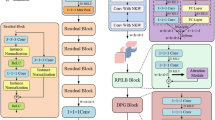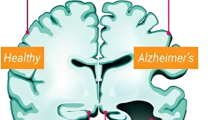Abstract
The application of imaging genomics to the detection of Alzheimer’s disease and the analysis of causative factors is of relevance. However, traditional studies are usually based on imaging data, thus neglecting the disease information implied by genetic data. In this paper, based on magnetic resonance imaging (MRI) data and single nucleotide polymorphism (SNP) data, we innovatively propose a novel data feature extraction method and construct a multimodal data fusion analysis model. Firstly, we pre-screen the SNP data and use the encoding layer in the transformer model for the screened SNP data to obtain the position information of each SNP in the sequence through the position encoding module, and then capture the features of the SNPs through the multi-head attention mechanism. Next, we perform feature extraction on the pre-processed MRI data. We adopt the idea of soft thresholding to extract the most discrepant features possible. To this end, we build a feature extraction module for MRI data that combines a soft thresholding module and a CNN module. Finally, we stitch together image features and genetic features and use a fully connected layer for classification. Through feature data fusion, our model was applied to multi-task analysis to identify AD patients, predict AD-associated brain regions, and analyse out strong correlation pairs between brain regions and risk SNPs. In multimodal data experiments, our proposed model showed better classification performance and pathogenic factor prediction, providing a new perspective for the diagnosis of AD.
Access this chapter
Tax calculation will be finalised at checkout
Purchases are for personal use only
Similar content being viewed by others
References
Khachaturian, Z.S.: Diagnosis of Alzheimer’s disease. J. Arch. Neurol. 4211, 1097–1105 (1985)
Kucmanski, L.S., Zenevicz, L., Geremia, D.S., Madureira, V.S.F., Silva, T.G.D., Souza, S.S.D.: Alzheimer’s disease: challenges faced by family caregivers. J. Revista Brasileira de Geriatria e Gerontologia 196, 1022–1029 (2016)
Mucke, L.: Alzheimer’s disease. Nature 4617266, 895–897 (2009)
Alzheimer’s Association: 2021 Alzheimer’s disease facts and figures. J. Alzheimer’s Dement. 173, 327–406 (2021)
Chen, X., Zhang, H., Gao, Y., Wee, C.Y., Li, G., Shen, D., et al.: High-order resting-state functional connectivity network for MCI classification. J. Hum. Brain Mapp. 379, 3282–3296 (2016)
Marchitelli, R., Aiello, M., Cachia, A., Quarantelli, M., Cavaliere, C., Postiglione, A., et al.: Simultaneous resting-state FDG-PET/fMRI in Alzheimer disease: relationship between glucose metabolism and intrinsic activity. J. Neuroimage 176, 246–258 (2018)
McEvoy, L.K., Fennema-Notestine, C., Roddey, J.C., Hagler, D.J., Jr., Holland, D., Karow, D.S., et al.: Alzheimer disease: quantitative structural neuroimaging for detection and prediction of clinical and structural changes in mild cognitive impairment. J. Radiol. 2511, 195–205 (2009)
Vemuri, P., Jack, C.R.: Role of structural MRI in Alzheimer’s disease. J. Alzheimer’s Res. Ther. 24, 1–10 (2010)
Feulner, T., Laws, S., Friedrich, P., Wagenpfeil, S., Wurst, S., Riehle, C., et al.: Examination of the current top candidate genes for AD in a genome-wide association study. J. Mol. Psychiatry 157, 756–766 (2010)
Hariri, A.R., Drabant, E.M., Weinberger, D.R.: Imaging genetics: perspectives from studies of genetically driven variation in serotonin function and corticolimbic affective processing. J. Biol. Psychiatry 5910, 888–897 (2006)
Huang, M., Chen, X., Yu, Y., Lai, H., Feng, Q.: Imaging genetics study based on a temporal group sparse regression and additive model for biomarker detection of Alzheimer’s disease. IEEE Trans. Med. Imaging 40, 1461–1473 (2021)
Bi, X.-A., Hu, X., Wu, H., Wang, Y.: Multimodal data analysis of Alzheimer’s disease based on clustering evolutionary random forest. IEEE J. Biomed. Health Inform. 2410, 2973–2983 (2020)
Kang, E., Jang, J., Choi, C.H., Kang, S.B., Bang, K.B., Kim, T.O., et al.: Development of a clinical and genetic prediction model for early intestinal resection in patients with Crohn’s disease: results from the IMPACT study. J. Clin. Med. 104, 633 (2021)
Venugopalan, J., Tong, L., Hassanzadeh, H.R., Wang, M.D.: Multimodal deep learning models for early detection of Alzheimer’s disease stage. J. Sci. Rep. 111, 1–13 (2021)
Nguyen, M., He, T., An, L., Alexander, D.C., Feng, J., Yeo, B.T., et al.: Predicting Alzheimer’s disease progression using deep recurrent neural networks. J. NeuroImage 222, 117203 (2020)
Basaia, S., Agosta, F., Wagner, L., Canu, E., Magnani, G., Santangelo, R., et al.: Automated classification of Alzheimer’s disease and mild cognitive impairment using a single MRI and deep neural networks. J. NeuroImage: Clin. 21, 101645 (2019)
Vaswani, A., Shazeer, N., Parmar, N., Uszkoreit, J., Jones, L., Gomez, A.N., et al.: Attention is all you need. In: Advances in Neural Information Processing Systems, pp. 5998–6008 (2017)
Donoho, D.L.: De-noising by soft-thresholding. J. IEEE Trans. Inf. Theory 413, 613–627 (1995)
Author information
Authors and Affiliations
Corresponding author
Editor information
Editors and Affiliations
Rights and permissions
Copyright information
© 2021 Springer Nature Switzerland AG
About this paper
Cite this paper
Li, Y., Liu, Y., Wang, T., Lei, B. (2021). A Method for Predicting Alzheimer’s Disease Based on the Fusion of Single Nucleotide Polymorphisms and Magnetic Resonance Feature Extraction. In: Syeda-Mahmood, T., et al. Multimodal Learning for Clinical Decision Support. ML-CDS 2021. Lecture Notes in Computer Science(), vol 13050. Springer, Cham. https://doi.org/10.1007/978-3-030-89847-2_10
Download citation
DOI: https://doi.org/10.1007/978-3-030-89847-2_10
Published:
Publisher Name: Springer, Cham
Print ISBN: 978-3-030-89846-5
Online ISBN: 978-3-030-89847-2
eBook Packages: Computer ScienceComputer Science (R0)





